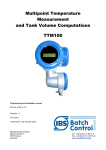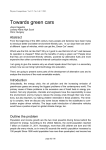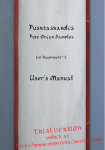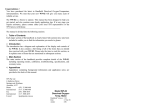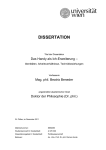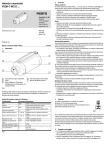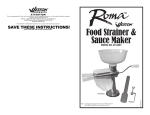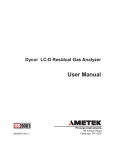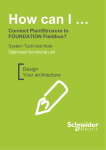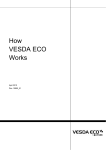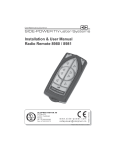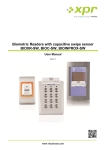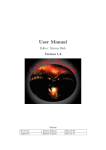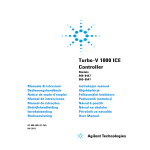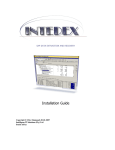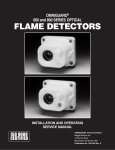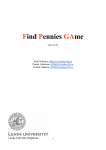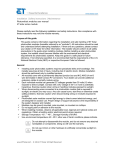Download Fluid flow sensor for application in the food and pharmaceutical
Transcript
Process automation Fluid flow sensor for application in the food and pharmaceutical industry Dezső Dányi - Dányi Engineering The development of the fluid flow measuring devices operating on the electromagnetic principle was started several decades ago in Hungary, in the manufacturing unit of Gamma Works situated in Budapest. Initially the production was made as a part of a manufacturing agreement together with the German firm Krohne for the German export, but shortly the product has become dominant at the domestic water- and wastewater plants. The present publication reports about the market introduction of a small fluid flow sensor, the development of which has been enabled by the research and development works based on the “Gamma traditions” made in Gamma Works. It is a fundamental requirement of the production of the measuring sensors in the field of the industry that the manufacturing rooks enabling the end review and the calibration of the manufacturing tools should be available The fluid flow measuring devices are in this respect special, since there are in general no ready available tools for their calibration, but the development of the product involves generally the development of the calibrating device as well. This applies in particular to the fluid flow measuring devices operating on electromagnetic principle [1]. The manufacturer has to use a calibrating device corresponding to the prescriptions of an international standard (the ISO 9104:1991 “Measurement of fluid flow in dosed conduits - Methods of evaluating the performance of electromagnetic flowmeters for liquids”) in order that the document issued for the product should be accepted as credible. The construction design and the method of building in have been already standardised within the European Union, and therefore the prescription of the standard MSZENISO 6817, “Measurement of conductive liquid flow in closed conduits. Method using electromagnetic flowmeters” should be kept both from the side of the manufacturer and that of the user. The operating principle of the fluid flow sensor operated on electromagnetic principle is based on the kinetic law of induction, according to which, if a conduct having a length of L is moved with a speed v, perpendicularly to a homogeneous magnetic field with a constant induction B, then the voltage u = BLv induced in the conduct is independent on the resistance of the conduct and depends only on the velocity of the conduct. In the induction sensors the conduct will be substituted by the electrically conductive fluid flowing between the insulated electrodes built in the tube wall. In reality this can be, however, realised only with countless compensations. One of the problems can be that the constant magnetic field can polarise the ions to be found in the fluid, which, deposited on the electrodes, can produce an insulating surface. To avoid this, the magnetic field will be generated with alternating pulses. The other problem is that the velocity of the fluid is not alike in the whole cross section of the tube, it is equal to zero at the wall of the tube and at the other points it will depend on the shape and the size of the previous and following tube section. Figure 1 Figure 3 Figure 2 Since the operation of the fluid flow sensor operating in the principle of the inductive measurement – within limits – is independent on the fluid properties, makes the utilisation of the sensor particularly advantageous in the fields of the pharmaceutical and food industries. Namely, the measuring tube of the fluid flow sensor operating on the induction principle is a straight tube made of insulating material, with smooth wall, not containing protruding elements and this circumstance makes the cleaning of the tube very easy and makes it suitable for the measurement of materials containing solid particles, pulpy, concentrated acid or alkali substances. Its disadvantage is however that it cannot be used for the measurement of insulating fluids, e.g. oil, gasoline. This disadvantage has been reduced, however, with the development of the electronics and the present designs are suitable for example for the measurement of the boiler feed water having only some (µS/cm) conductivity as well. A further disadvantage is that in the case of installing the sensor great attention should be paid to grounding of the fluid flow sensor, since the induced voltage serving for the measurement has mV order of magnitude and if the insulation resistance of the pump assuring the flow of the fluid is not high enough, then – in the case of improper grounding – the leakage current will be closed through the sensor toward the ground and this will tamper the test signal. The miniature fluid flow measuring devices – in general measuring up to 100 L/min – form a separate group of the electromagnetic fluid flow sensors that are to be used in built-in state as part of a device. Their manufacturers, the so called OEM (Original Equipment Manufacturer) users put up special demand concerning the easy interchangeability and therefore the pipe connections of the devices to be built in are therefore standardised. The SENSOFLO™ fluid flow sensor product family developed by us applies Clamp pipe fittings – that are widely used in the pharmaceutical and food industries according to the DIN 32676 and ISO 2852 standards – as part of the measuring tube, which means that the measuring tube and the pipe fitting form one unit during the calibration (Figure 1). The same principle is also applied for the widespread plastic tubes with the difference that there the pipe fittings Adaptor Union widely spread by the Swiss Georg Fischer firm will be built in before the calibration (Figure 2). It is a great advantage of this solution that the pipe fittings can perform the task of the grounding of the of the fluid simultaneously as well, since the metallic parts of the pipe fittings to be found on the two sides of the measuring tube have been Figure 4 electrically connected to each other in the factory and thereby the circuit of the pump leakage current cannot be closed through the measuring tube. The diameter nominal DN25 and DN40 stainless steel tubes, as well as the stainless steel tubes with nominal diameter of 1” and 1.5” use the same Clamp pipe fitting with a diameter of 50.5 mm, which are generally applied in the American and Far East markets. This is very advantageous at the development of the calibrating device, since the DIN standard used in the European Union specifies the inner diameter of the pipe, while the ISO standard widely used in the USA specifies the outer diameter of the pipe. Thereby the scope of utilisation of the fluid flow sensors calibrated with the Clamp fitting is very wide. The widespread application is promoted by the fact that the electronics of the SENSOFLO™ has a variety of output signals (adjustable pulse value of 1, 10, 100 or 1000/liter, transmitter output of 4...20 mA, as well as RS485.) The output signal of the switch having three positions enables a special application. The output signal of the pulse value is a signal generally used, if the fluid flow sensor is connected with a PLC Programmable Logic Controller) The digital output signal according to the standard RS486 can be used, if the fluid flow sensor is connected to a computer network. Namely the MODBUS RTU-protocol applied to the digital output signal is free to user, and so it stands before a wide spread, similarly to the widespread analogous 4...20 mA DC signal [2], [3]. The above mentioned output signals are routed to connectors on the rear of the sensor (Figure 2). The speciality of the device is the output switch having three Figure 5 positions bled through the power cord. This switch will switch at an adjustable fluid quantity or fluid velocity and by means of it an actuator (electromotor or electropneumatic transformer) can be operated. This will namely allow that the SENSOFLO™ fluid flow sensor can be applied for metering and fluid flow adjusting task, too. The design of the backsheet can facilitate the assembly of the device to a great extent. The “LED” labelled red indicates that there is power, the “LED” labelled green indicates that fluid flow exists. The QR code with “FLOW” label decoded with a smartphone the User Manual can be read. An important way of application of the fluid flow sensors is the measurement of the flow rate. Therefore the electronics design is such that only one way flow will be detected; therefore it is of great importance at the installation of the device that the flow direction be the same as the direction of the arrow to be found on the side of the device. At such applications it is an important aspect that the feed cannot be switched off, since each switching on operation some time is necessary for the revival of the electrodes that can tamper the measurement result. The measurement result can be also tampered by the flow of fluid leakage during stoppages. This failure will be eliminated by the SENSOFLO™ fluid flow sensor so that in the lower 1…5% of the measurement range to be adjusted the flow rate will not be measured. At applications in the pharmaceutical industry, it is an essential aspect that the fluid flow sensor be explosion proof. If the fluid measured is not explosive in itself, the device may still be in the vicinity of pipelines containing flammable substances that, in case of failure, raise the risk of explosion. Each electromagnetic sensing electronic device contains a magnetic circuit having significant inductance, which cannot be made spark ignition free. This problem is resolved in the SENSOFLO™ fluid flow sensor so that the part containing the electronic power supply and the coil is cast out of plastic resin and therefore in the case of a failure in the hazardous area no sparks can create ignition. The utilisation in an explosion dangerous area the usability demands the solution, where the feeding and the circuit of the switching circuit having higher current intensity as 100 mA are not connected through the connector, but should be connected with a cable, galvanically isolated from the inner electronic device with the sensor. In the case of a dosing application the switch circuit of the SENSOFLO™ will open a valve so long as the set amount of fluid will flow through and the valve will be closed. The fluid flow display unit SENSOFLO™ can be put to the connector labelled “DISPLAY” to be found on the backboard of the device (Figure 3), and on the front cover of this the quantity read to be charged can be adjusted and the actual flow rate can be read. In the application in the field of the food and pharmaceutical industries the assembly of the SENSOFLO™ fluid flow sensor with the actual quantity can be read. At the applications in the Food industry and in the Pharmaceutical industry the assembling with the Painter valve VZQA is particularly advantageous, since this valve has the same diameter as that of the measurement tube of the sensor. where the quantity of the amount of liquid flowing through can be adjusted by the compressing of the tube wall using air (Figure 4). Thereby the valve will be a part of the measurement tube and can be calibrated together with it and will correspond to all cleaning requirements, The flowing characteristics of the valves applied for setting purposes will be in general influenced by the practical geometric design of the valve seat/valve body group [4] [5], The movement of such valves is assured with an electromotor or pneumatically with a feedback to the place of the valve-stem, using the so called positioning device. The disadvantage of this solution is that the set pattern is only fulfilled, if a pressure drop of 1 bar will be realised. The valve characteristic can be made independent using a solution being under patent application from the pressure drop to be found at the valve, if the valve will be assembled with the SENSOFLO™ fluid flow sensor and the flowing through fluid flow will be fed back to the governing signal. The so developed fluid flow adjuster has the great advantage that the special design of the valve seat/valve body group is not necessary. The technologies used in the chemical industry requiring stirring commonly use not the continuously, but suddenly will be called out with a ration, acting “batch processing” technology. The essence of this is that – under regulated temperature and pressure ratios – during continuous mechanic stirring another substance will be added to the liquid-phase raw material and as a result of this operation after the reaction time another product will be created. In the food industry, for the most part, it is unnecessary to split the process in portions in the case of creating a new product; it is much more appropriate to use of continuous rather than intermittent technology, where the stirring will be performed using a static stirring device. For the adjustment of the static stirring devices, the SENSOFLO™ fluid flow sensor assembled with valve shown in the Figure 4 is particularly appropriately used, since its flowing characteristic is independent on the pressure drop occurring at the valve. Figure 5 shows the utilisation of the SENSOFLO™ fluid flow sensor for the adjustment of the stirring devices. The technological task is the creation of the product C with the mixing of the products A and B. The flowing quantity of the fluid transported by the pump 1 will be measured by the fluid flow sensor 2 and the measurement signal will be added to the adjusting device 3. The SENSOFLO™ fluid flow sensor assembled with the valve 4 measures the flowing quantity of the fluid B and transmits it to the adjusting device, which adjusts the valve 5 so that the ratio of the fluid flows A and B be the prescribed value in front of the static mixer independent on the pressure drop. Dányi Engineering - DE Flowmeters Kft. 1141 Budapest, Cserebogár utca 39. Tel.: +36 1 469 0485 E-mail: [email protected] www.danyi-engineering.hu LITERATURE [1] György Léb, Dr. László Szilassy: Ami egy 0,1%-os áramlásmérő-hitelesítő mögött van [Principles behind a 0.1% calibrating device]. Magyar Elektronika, 2014/1-2 [2] Ferenc Pástyán: Áram-és teljesítménymérők RS485 interfésszel [Current and performance measuring devices using RS485 interface]. Magyar Elektronika, 2014/10 [3] Com-Forth Ltd: Kísérletezés helyett – intelligens RS485 [Instead of experimenting – intelligent RS485]. Magyar Elektronika 2014/5 [4] Dezső Dányi, Dr. Zoltán Telkes: Szabályozó berendezések [Control devices], College textbook. Tankönyvkiadó, Budapest, 1981 [5] Péter Mizsey: Folyamatirányítási rendszerek [Process control systems], College textbook. TYPOTEX Budapest 2011.



